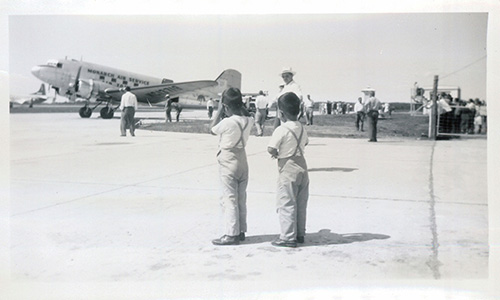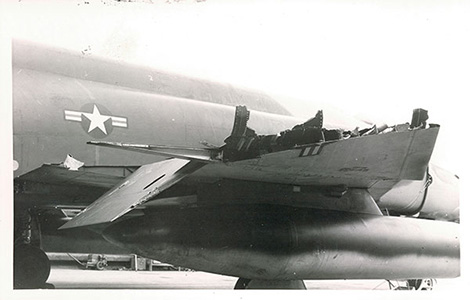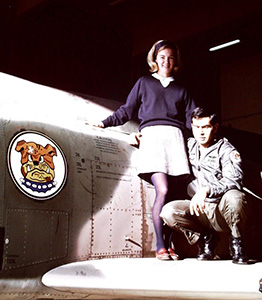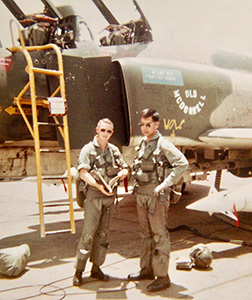U.S. Air Force Vietnam War Park Ridge, IL Flight date: 04/13/22
By Paul Mally, Honor Flight Chicago Veteran Interviews Volunteer
Udorn Royal Thai Air Force Base was a hub of activity during the Vietnam War. Located in northeastern Thailand, it was one of the major centers of U.S. Air Force combat operations over North Vietnam and Laos during that conflict. In 1968, it was the home of the 13th Tactical Fighter Squadron, the “Panther Pack” and a newly arrived pilot on his first combat tour, Dave Adams.
Dave’s journey to Udorn began just a few years earlier while attending St. Olaf College in Northfield, Minnesota majoring in history. In May 1966, Dave graduated from Air Force ROTC as Distinguished Graduate which allowed him to receive a regular commission as a 2nd Lieutenant. He also earned his FAA private pilot certificate.
More advanced undergraduate training continued in Texas, moving from basic Cessna 172 propeller aircraft to more advanced T-37 and T-38 jets. Dave and his fellow pilots learned to fly “the Air Force way” and learned aerobatics, formation and instrument flying. Graduates from this course were also certified as FAA Commercial Pilots. Upon completion of this phase of training, pilots were able to request their preferences for the type of aircraft they would like to fly – bombers, tankers, transports. Every aircraft type required a great level of skill and everyone had their part to play. Being among the top of his class, Dave got his first choice – fighters.
After a course in advanced survival training near Spokane, WA, the next stop was Davis-Monthan AFB in Tucson, Arizona. Dave trained here in the aircraft he would fly in combat: the legendary McDonnell – Douglas F-4 “Phantom II” twin seat fighter. After some additional training in sea and jungle survival in Florida and the Philippines, Dave’s next stop was to be the Vietnam War, traveling to Udorn via Bangkok.
Thailand is a world away from the midwest U.S.A.where Dave spent his early years. He was born in Chicago at Norwegian American Hospital to his parents Lois and Albert. Albert Adams was native American, a member of the Menominee Indian Tribe of Wisconsin. His parents met in Green Bay where Albert was in the hospital recuperating from a logging injury. Dave’s younger brother, Robert, completed the family of four. During World War II, Dave’s father Albert worked at the massive Joliet Arsenal where munitions for that war effort were manufactured and stockpiled in acres of underground bunkers. In 1946, the family moved back to Green Bay where Dave attended Green Bay West High School. (To this day he is a loyal Packers fan!) Dave recalls that his earliest exposure to aviation occurred when his family lived near an airport on the outskirts of town. Dave’s Mom took a picture of him at an airshow looking at a plane that may have sparked his interest. (A photo shows Dave, on the left, with his brother Robert.) But it wasn’t until college that flying really became a serious pursuit.
Now, with training completed, Dave found himself in Thailand in the middle of a war and the serious business of being a combat pilot began. During Dave’s first tour, an Air Force F-4 was crewed by two pilots. The pilot in the cockpit front seat was the aircraft commander. His job was to fly the aircraft and expend the rockets, bombs and missles. Dave was the “GIB” (guy in the back) who controlled the radar and related systems and could actually fly the aircraft as needed. Flying in the front seat was Major Dudley Foster. (A photo shows the two in their flight gear next to an F-4 named “Old McDonnell”). What was a “typical” day for an F-4 pilot flying a mission? When you got up in the morning, what was the first thing you would do? Dave explains: “Eat breakfast!” and goes on to describe the mission step by step.





“Usually the ‘Frag Order’ would be posted the night before. This would tell you who you would be flying with, take off time and then back up to briefing time. Then there would be an intelligence briefing
for everyone flying that day. Next, you would brief the flight about 2 hours before take off time. Next you would establish station time (about 30 minutes before take off) where you would preflight the airplane and check the weapons which had already been uploaded to the airplane by the ground crews.
The inertial navigation system had to be aligned and target coordinates had to be entered into that system, this was before GPS. Dave continues, “Typically daytime sorties would consist of four ships. There would be an engine start time and then each of these aircraft would leave their protective revetments and taxi out to the arming area. In that busy place the ground ordinance crew would ‘pull the pins’ and arm the various missiles, bombs, rockets and extra fuel drop tanks. Once the weapons were armed, the flight was ready to go. We lined up in staggered formation and would take off individually in 10 second intervals (for safety). The airplanes were always loaded to the max, with 60,000 lbs plus total weight so you had to have an opportunity to abort (takeoff) in an emergency. The F-4’s would trail black smoke from their engines and were easy to spot. After about five minutes, the aircraft would catch up with each other. We always had a KC-135 tanker ready to top off our fuel enroute to the target area. A lot of gas would be burned just on takeoff.”
Now the flight would proceed towards three previously assigned targets, either in North Vietnam or Laos. A C-130 airborne controller plane, which had earlier taken off from Udorn, would then confirm exactly which target to hit: primary, secondary or tertiary. The target designated would then be attacked. Typical targets would be the “Ho Chi Minh Trail ” a critical supply route from North Vietnam to the NVA and Viet Cong truck parks, ammo depots and road intersections. Approaching the target, the planes would dive, to release their bombs and pull out at 5Gs to recover before reaching 4500 ft. altitude above the ground so as to try to avoid anti-aircraft fire from a variety of cannons, machine guns and surface to air missiles. Pulling up out of the dive, the pilots would try to eyeball the target and “score” their hits. As seen in a photo, during one such mission, the wingtip on Dave’s F-4 sustained battle damage from anti-aircraft fire but he returned safely back to base. Describing close air support missions, “We always worked with a forward air controller for those targets. They were called Ravens.” These were slower propeller planes that would mark the targets with white phosphorus smoke rockets. Raven pilots had a risky job and were more often hit by ground fire. Returning to base, the fighters would again rendezvous with a KC-135 stratotanker to add fuel in case they needed to divert to another base. After landing, the planes would proceed to the de-arming area where unfired weapons, if any, would be made safe again by the ground crews. The mission completed, the pilots would be debriefed by intelligence officers to get an overview of bomb results, anti-aircraft fire encountered, or any other information of value.
Dave’s first tour in Thailand was from May 1, 1968 to January, 1969. From January to July, 1969 he was assigned to the F-4 Replacement Training Unit at George AFB, CA where he was able to pass on his knowledge to his fellow pilots slated for deployment to Southeast Asia. He graduated as an Aircraft Commander.
In September, he returned to Thailand and the 13TFS and began his second combat tour on October 4, 1969. The missions now were all in Laos as the bombing campaign in North Vietnam had been suspended. “We had many more night sorties then. On my first tour I didn’t have any. Typically night sorties would involve two (instead of four) F-4s and we would escort AC-130, AC-47 or AC-119 gunships.” (These planes were heavily armed with mini guns and aerial cannons that could deliver devastating firepower on ground targets.) “These sorties were an hour long on station and we would work closely with the gunship pilots.” Refueling by KC-135 tankers was also done during these night missions. “Night sorties were exciting.” Dave describes how they would protect B-52 bombers. “Sometimes we were on MiG (Soviet made fighter) CAP protecting the bombers from fighters that could attack them from North Vietnam.” Officially during this time, the United States military was not supposed to actually be in Laos; however the CIA was conducting “black ops” in that country with the help of Laotian tribesmen. “We dropped more bombs in Laos than the Allies did during the entirety of WWII worldwide.”
During this second tour, Dave’s wife Barbara joined Dave for a time in Thailand. Dave and Barbara had met back in college and they had married prior to his first combat tour. Barb was a nurse, and was able to get a job with the Presbyterian Mission Hospital in Bangkok. This enabled them to visit each other every couple of weeks. During her visits to Udorn, Barb would see F-4s leaving the base on missions from the hotel pool. Dave tells, “It was a little nerve wracking because ‘are you going to come back or not?’ but I always came back and would call her to let her know I was OK.” “While pilots were allowed to have their wives with them, it was not encouraged, even discouraged. We were able to spend some time in Bali, Indonesia before we left. She knew what she was getting into, but on that second tour she said she was coming and she worked it out. She’s pretty independent.” Dave and Barbara raised three children, daughter Karen and sons Matthew and Erik. They now have four grandchildren!
Dave’s last combat flight was on July 25, 1970. With 105 combat sorties in North Vietnam, then adding his combat sorties in Laos, he accumulated a total of 244 combat sorties in his two tours. Dave flew 430.5 combat hours and 9.2 combat support hours. From 1970 to 1973, Dave was assigned to Bitburg AFB, West Germany with the 525th TFS “Bulldogs” including duties as a flight commander, flight instructor, air combat tactics instructor, detachment commander and forward air controller. (A photo shows Dave and Barbara perched on the wing of an F-4 there.) He was a selectee for the Fighter Weapons School at Nellis AFB, NV. In June of 1973, he was honorably discharged. From 1978 to 1980, Dave held a reserve commission and flew an F-4 with the 191st Fighter Interceptor Squadron, Michigan Air National Guard.
He completed his service as a Captain and Senior Pilot with the following decorations and awards including: Distinguished Flying Cross with 2 Oak Leaf Clusters, Air Medal with 21 OLC, Air Force Commendation Medal, Presidential Unit Citation Southeast Asia with 1 OLC, Air Force Outstanding Unit Award with Combat “V” Device with 1 OLC, Vietnam Service Medal with 3 OLC plus others.
What Dave remembers most about his service was “the esprit de corps, the camaraderie and the friendships” with his fellow fighter pilots that continue to this day.
After his Air Force service, Dave pursued his education, obtaining his J.D. degree from the University of Michigan in 1976. (His “part time college job” was flying Learjet cargo planes!) Dave went on to a distinguished legal career with admissions to higher courts throughout the country, including the United States Supreme Court.
Dave and Barb now live in Park Ridge and are involved in several professional and community organizations. For several years, Dave Adams has been a valued Honor Flight Chicago volunteer and member of our interview team!
Thank you for sharing your story with us and for your courageous service to our country! Enjoy your well-deserved Honor Flight with your fellow veterans. Clear skies and happy landings, Dave!


